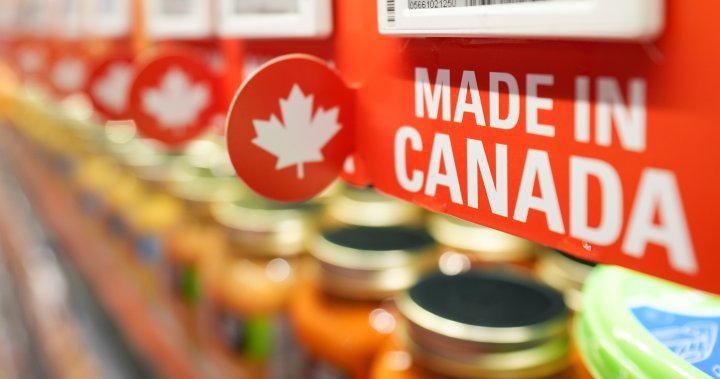There’s still some confusion on the difference between “Made in Canada” and “Product of Canada” designations but a survey shows once Canadians understand, there’s a major shift in buying habits.
Among Canadian consumers who said they didn’t know the differences in the terms, 37 per cent said they would prefer to buy a “Made in Canada” product, while 23 per cent would choose a “Product of Canada.”
Another 40 per cent reported no preference.
When the definitions of each were explained, however, just 12 per cent said they would choose a “Made in Canada” product, while 66 per cent chose a “Product of Canada.”
Those with no preference dropped to 21 per cent.
The survey also found 63 per cent say they are actively seeking out Canadian products when shopping, and 53 per cent are looking at labels to avoid products made in the U.S.
The survey, conducted online by Narrative Research between Feb. 12 and 14, asked 1,232 Canadians 18 years and older for their views.
“People don’t understand ambiguous phrases,” said Lorna Merrick, who lives in Medicine Hat, Alta., and spoke to Global News on Thursday about her efforts to buy mainly Canadian products.
“Definitely looking at buying a ‘Product of Canada’ over top of a ‘Made in Canada’ [item] because there’s still money going elsewhere for the raw materials,” she said about the ‘Made in Canada’ label.
Merrick said she’s been primarily avoiding U.S. products when grocery shopping, focusing on buying food from Canada, though she added she will sometimes buy items from Mexico or even Japan if needed.
On a recent grocery trip, she said she didn’t buy carrots as planned because those that were available at the store were all from the U.S.
“People talk it’s a ‘drop in the bucket’; no, it’s not a drop in the bucket because of the fact stores are taking note, companies are taking note,” she said.
When it comes to each label, there are differences in the amount of Canadian content that goes into each, and it’s not just referring to ingredients.
For non-food items, Canada’s Competition Bureau places a “higher threshold of Canadian content” at 98 per cent for anything labelled a “Product of Canada.”

Get daily National news
Get the day’s top news, political, economic, and current affairs headlines, delivered to your inbox once a day.
Meanwhile, “Made in Canada” labels for non-food items are subject to a 51 per cent threshold of Canadian content “but should be accompanied by a qualifying statement indicating that the product contains imported content,” the bureau states in 2009 guidelines.
Food products work slightly differently.
The Canadian Food Inspection Agency says a food product can use “‘Product of Canada’ when all or virtually all major ingredients, processing, and labour used to make the food product are Canadian.”
A food product labelled “Made in Canada” with a qualifying statement means the “last substantial transformation of the product occurred in Canada, even if some ingredients are from other countries.”
Canadian independent grocers say they’re seeing an increase in the number of people looking specifically for “Made in Canada” or “Product of Canada” labels.
“I’ve never seen such a demand in the 20-plus years that I’ve been with the independent grocers,” said Gary Sands, senior vice-president of the Canadian Federation of Independent Grocers (CFIG).
While specific numbers in terms of revenue or classification of items purchased are not yet available, Sands said the CFIG’s members have seen people “demanding” to see more Canadian products.
That demand has also spurred independent local grocers to, in some cases, change what they’re bringing into the store, with some sourcing produce like grapes or lettuce from South America or Africa because “customers are not buying it if it’s American.”
“I think what’s happened is it’s sort of touched something in the Canadian psyche or soul, and our members are hearing very directly from customers,” Sands said.
“An independent grocer lives in the community, they buy local, they hire local, so customers are not really reticent about expressing their feelings and, as I said, in this case they’re demanding more Canadian products to be in the store and they are very adamant they want to see that identification.”
The Canadian Federation of Independent Business (CFIB) says its members are seeing customers ask staff what each type of Canadian label means.
“Customers are being very conscious of how they’re consuming right now,” said Ryan Mallough, the CFIB’s vice-president of legislative affairs.
But while the survey showed a shift from “Made in Canada” to “Product of Canada” once the definition is known, the CFIB is reminding Canadians not to shy away from either if they’re buying at a locally owned business.
“When you support a local business in Canada, $0.66 of that dollar stays local, so only $0.11 at a multinational, it’s only $0.09 at an online giant like Amazon,” Mallough said.
“If you are shopping at your local small businesses, you are in line with that supporting Canada nature and then you’re not having to worry about checking the products or the percentage of products, you’re supporting a Canadian business, you are supporting this movement and you’re on the right track.”
— with files from Global News’ Saba Aziz
© 2025 Global News, a division of Corus Entertainment Inc.
Read the full article here

